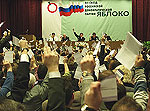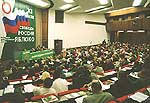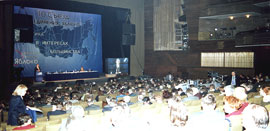Nikolai Rybakov: 1,000 missed chances. How and when did we miss the opportunity for peace?
Nikolai Rybakov special for the Yabloko web-site, 19.11.2024
People think that if they call mass murder “war,” then
mass murder will stop being a murder, a crime.
Leo Tolstoy

Photo: Painting by Viktor Vasnetsov “Warriors of the Apocalypse” (1887) depicting the four horsemen of the Apocalypse – characters from the Sixth chapter of the Revelation of John the Theologian
The 24th of February, 2022 became a tragic date for many of us, a turning point in life and a day after which no one and nothing will be the same. During the military actions, we have lost a lot and many people. And if good-neighbourly relations with Ukraine and the West, destroyed infrastructure and houses, and a stable economy can be restored, maybe not now, and not immediately, but still it is possible, then we will never be able to bring back those who died in this bloody massacre.
Today, on the 1,000th day of the conflict, Vladimir Putin urgently introduced changes in the nuclear doctrine a day after the publication in The New York Times that US President Joe Biden had given permission to fire Western ATACMS missiles at Russian territory. While we are watching yet another absolutely cynical geopolitical chess game with the subtext of “let’s see who wins”, those who will die will be those who never made any decisions about escalation, who wanted to live, love, and raise children.
On Those Killed During These 1,000 Days
Today, none of us knows for sure the number of dead – neither in Ukraine nor in Russia. In this matter, we can only rely on UN reports, rare reports on killed fellow countrymen in regional media, and the rapidly expanding cemeteries with tricolour Russian flags fluttering in the wind, which I personally have seen many times when visiting Russia’s regions.
Back in 2015, Vladimir Putin classified the Russian Defence Ministry’s data on military casualties “in peacetime during special military operations”; previously, the decree only applied to wartime. In this regard, data on the Russian side’s losses in the Ukrainian conflict is unlikely to be published. At least not until the conflict is over.
Nevertheless, President Putin did announce something in the summer of 2024 at the St.Peterburg International Economic Forum. He stated that the irreparable losses of Russia and Ukraine were approximately one to five. According to him, the Ukrainian Armed Forces were losing 50,000 people killed and wounded per month, a ratio of approximately 50 to 50.
The Russian Defence Ministry last report on the losses of the Russian army was in September 2022: 5,937 people for 210 days after 24 February. And on 23 April, 2024, then-Defence Minister Sergei Shoigu said that Ukraine had lost almost 500,000 people since the start of hostilities in February 2022. At the same time, Ukrainian President Volodymyr Zelensky reported a month earlier that the losses of the Ukrainian Armed Forces during the conflict amounted to 31,000 dead.
On 17 September, 2024, The Wall Street Journal, citing Ukrainian sources and Western intelligence data, published data that the number of people killed and wounded during the conflict in Ukraine had reached one million.
The Russian authorities demonise Ukraine, talk about the impossibility of negotiating with Ukraine – either because of Zelensky’s illegitimacy, or because of the non-recognition of the very right of the Ukrainian state to exist (former President Dmitry Medvedev has been writing about this especially often), or because of the “bloody coup” (it is not very clear how it differs from 1917) and the “Kyiv junta in power”. But it turns out that negotiations on secondary issues are underway. So, there is recognition after all. And there are channels. We need to move on to the main issue, because what could be more important than life? It should be noted that similar demonisation and “the impossibility of negotiating with Russia” on the other side does exist in the same volume.
Exchange of Prisoners of War and Bodies of the Dead
During the thousand days of bloodshed, there were just as many chances to stop killing of people, but none of these chances were used thoroughly. If many believe that the Istanbul Agreements were the only such opportunity to conclude peace, they are mistaken. Over the past three years, it has become clear that negotiations have been underway in other areas, sometimes with the help of intermediaries, and through a variety of channels and issues.
For example, according to journalists, exchanges of prisoners of war and bodies of the dead have already taken place between Russia and Ukraine more than 50 times. The last such exchanges, according to the Russian Defence Ministry, took place on 18 October (95 for 95) and on 14 September (103 for 103) – in both cases, the United Arab Emirates (UAE) was the intermediary. In August 2024, the exchange took place according to the formula 115 for 115, in July – 95 for 95, and in June – 90 for 90. So, they did find a way out?
Prisoner Exchange
Let us also take as an example the large-scale prisoner exchange that took place on 1 August, 2024 – seven countries took part in it: Russia, the USA, Germany, Norway, Slovenia, Belarus and Poland. Then, during the exchange, eight people from six countries were transferred to Russia, and Russia transferred 16 political prisoners, of which 13 people were transferred to Germany, and three to the USA. So, they did manage to reach an agreement here too?
The Grain Deal
Let us also remember the grain deal that was concluded between Russia, Ukraine, Turkey and the UN in Istanbul on 22 July, 2022. At that time, Russia and the UN simultaneously signed a memorandum, according to which the UN pledged to facilitate the removal of obstacles to the exports of Russia’s grain and fertilisers. The grain deal allowed Kyiv to export grain and other agricultural products blocked after the start of the special military operation. The agreement guaranteed safe passage for ships with Ukrainian cargo from the country’s three key Black Sea ports (Odessa, Chornomorsk and Yuzhny), which accounted for more than a third of all Ukrainian agricultural exports. Moreover, the deal was initially concluded for only 120 days, but after that it was extended several times. On 18 July, 2023, it ceased to operate after Russia refused to extend it, promising to return, but subject to a number of demands, one of which was the lifting of the restriction on disconnecting Rosselkhozbank from SWIFT, but the West then decided not to connect the Russian bank to the international payment system due to concerns that the bank would be used not only to support transactions for the export of grain and fertilisers, but also for other purposes. Despite the fact that the deal ceased to exist, it nevertheless lasted for a whole year. It turns out that a compromise was found here too?
The Deal on Banning Strikes on Energy Facilities
A deal on banning strikes on energy facilities was also planned proceeding from the grain deal principles and with the mediation of Qatar – the Financial Times wrote about it, but the negotiations were disrupted after the Ukrainian Armed Forces invaded the territory of the Kursk region. Considering the rapidly approaching winter, this dialogue may resume soon.
Gas transportation
Another important example is the agreement on gas. Two operating gas pipelines (we are talking about Urengoy-Pomary-Uzhgorod and Progress) that pass through the gas metering station Sudzha in the Kursk region, and then through the Sumy region of Ukraine – that is, through the territories where military actions are taking place now. During all the 1,000 days of endless shelling, there was not a single report of damage to the transit gas pipeline. At the same time, no politicians from neither of the sides have made public statements about the agreements not to harm the gas pipelines. Perhaps it was possible to reach an agreement here too (even if behind closed doors)?
Look for yourself – how many times during the conflict in Ukraine it was possible to find a way out or mediators so that to solve economic or political problems. So, after all, the idea of a possible peaceful solution to the issue does exist and there is a chance to agree on a ceasefire and save human lives? It turns out that there is no wall between us?
How to Achieve Peace
It is possible to agree on stopping killing people. This could have been done at numerous UN Security Councils, at the NATO summit, at the the Shanghai Cooperation Organisation summit, at the St.Petersburg International Economic Forum, at BRICS, at the G7, and G20 – at any venue. It was possible to attract mediators – Turkey, Qatar, or the UAE, not to mention the more significant China, India or Brazil – anyone, but to agree on the need to stop killing people already today, now. The most important thing in this matter is that if there are not enough resources, intelligence, connections, diplomatic skills and political experience to return peace – then it is important to simply not put obstacles to the ceasefire agreement, not to call for continued escalation, not to multiply human casualties, all this without even risking one’s life.
In the meantime, with any illusory hope for peace, there are those who are again asking for blood, bread and circuses. Alas, just like the invasion of the Ukrainian Armed Forces into the Kursk region, as well as the information that US President Joe Biden has allowed Ukraine to fire missiles deep into Russia, and the amendments to the nuclear doctrine introduced by Vladimir Putin, are distancing us all from peace. This is nothing more than a proposal to turn 1,000 days of bloodshed into 2,000 days, turn dozens of destroyed citied into hundreds of destroyed cities, and turn thousands of killed and injured into a million killed and injured.
All this will continue, but someday it will still end in peace and a ceasefire. So why digging new graves every day in order to come to this decision anyway?
 NIKOLAI RYBAKOV
NIKOLAI RYBAKOV
is Chairman of the Yabloko party, member of the Federal Political Committee of the party, member of the Yabloko Bureau.
Head of the Yabloko Electoral Headquarters
Posted: November 20th, 2024 under Human Rights, Russia-Eu relations, Russia-Ukraine relations, Russia-US Relations, Без рубрики.






